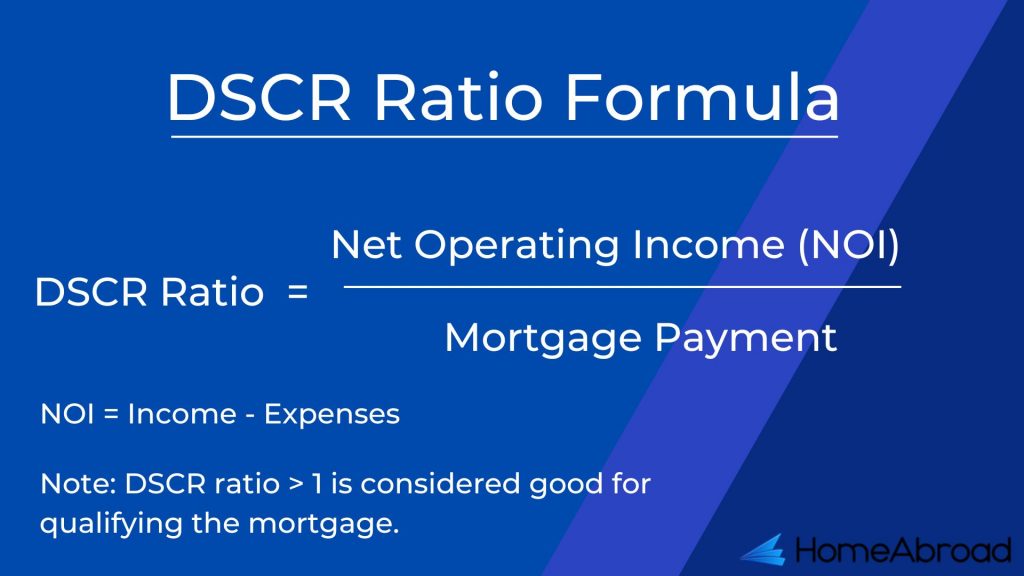Table of Contents
DSCR Loan Approval Cases by DSCR Ratio
| DSCR Ratio | Loan Approval | Down Payment |
| DSCR > 1 | Ideal | 20-25% |
| DSCR = 1 | Possible | 20-25% |
| DSCR < 1 | Possible | 40% |
Note: Not all lenders cater to the last case (DSCR < 1), so look around to find the lender ready to approve your loan with less than the required DSCR ratio. Such DSCR lenders ask for a higher down payment and interest rates.
Definition of the Debt Service Coverage Ratio Calculator
A Debt Service Coverage Ratio (DSCR) calculator is a financial tool that helps people and businesses determine their ability to cover their debt payments with the rent from the property.
- Calculate by dividing the net operating income (NOI) by the total debt service (TDS), which includes all principal and interest payments for a specific period.
The DSCR calculator provides a ratio that indicates the income generated by a property compared to the amount of debt needed to pay debt service.
This ratio is critical to lenders who use it to determine the borrower’s ability to make payments and assess the risk of default on the existing or new loan amount.
- A high DSCR (typically above 1.0) indicates that the borrower has sufficient income to cover their debt payments, which makes them a safer candidate for a loan or investment.
- A low DSCR (below 1.0) indicates the borrower might have difficulty making their debt payments and may be considered a riskier investment.
With this calculator, individuals and businesses can determine their DSCR quickly and accurately, which can help them make informed decisions regarding their financial position and investment strategies.
Example of DSCR Loan Calculator
Let’s look at an example of how the DSCR loan calculator works.
- Step 1: Determine the Total Debt Service (TDS) payments: $25,000 annually
- Step 2: Calculate the Net Operating Income (NOI): $50,000 in net operating income
- Step 3: Divide the NOI by TDS: 50,000/25,000 = 2.0
- Step 4: The Debt Service Coverage Ratio (DSCR) is 2.0, meaning it can comfortably cover debt service payments over the years payment period with cash flow to spare. It is considered a financially healthy ratio.
It indicates that the property generates enough income to cover its debt payments twice, earnings before interest taxes, making it an attractive prospect for lenders and investors.
If you want to find the best DSCR loan lender, you can do so by reading about these seven easy tips. You can also click below to start your journey with the best DSCR lender.

Pre-qualify for a DSCR Loan in a Few Clicks.
No Paystubs, W2s, or Tax Returns Required.
Overview of What is Included in a DSCR Calculation
The DSCR calculation considers several factors when determining borrowers’ debt repayment ability. These include:
- Total debt (principal and interest payments)
- Potential property income
- Property expenses
- Management fees
- Capital expenditures
Considering these factors, the DSCR calculator’s report can accurately assess a borrower’s ability to pay back the debt and the risk of default. This information lets lenders, borrowers, and investors make informed decisions about potential investments or loans.
To stay up-to-date on the latest DSCR loan interest rates, visit our blog for frequent updates. This way, you’ll always get all the essential news updates on the DSCR interest rate!
The formula for Calculating DSCR
The formula shows that the debt service coverage ratio, or DSCR, is calculated by dividing the net operating income of a property by its total debt service. This number represents the net operating income available to pay off debt obligations.

Net Operating Income (NOI) ÷ Total Debt Service (TDS) = DSCR
If the DSCR ratio exceeds 1.0, the borrower has enough income to cover their debt payments. However, if it is lower than 1.0, the borrower may have difficulty making their debt payments and could be considered a riskier investment.
How do you Calculate Net Operating Income and Debt for DSCR Calculator?
Net Operating Income (NOI) measures the income generated by an asset or property after including all operating expenses, such as taxes and maintenance. You can calculate NOI using the following formula:
Gross Income – Vacancy Loss – Operating Expenses = Net Operating Income
Total Debt Service (TDS) is the monthly payment required to pay off all debts over a year, including principal and interest. Calculate TDS using the following formula:
Principal Payments + Interest Payments = Total Debt Service.
The DSCR Calculator is valuable for lenders, borrowers, and investors. With this calculator’s report alone, these parties can assess the financial health of potential investments or loans by calculating the Debt Service Coverage Ratio (DSCR).
This ratio considers total debt, potential property income, capital expenditures, and management costs to gauge borrowers’ ability to repay their debt accurately.
Example of DSCR Calculation
Let’s look at an example of a DSCR calculation:
Net Operating Income = Rental Income – Vacancy Loss – Operating Expenses
NOI = $50,000 – $2,000 – $10,000 = $38,000
NOI= $38,000
Total Debt Service (TDS) = Principal Payments + Interest Payment
TDS = $20,000 + $5,000 = $25,000
TDS = $25,000
Debt Service Ratio (DSCR) = Net Operating Income (NOI) / Total Debt Service (TDS)
DSCR = $38,000 / $25,000 = 1.52
DSCR = 1.52
This results in a Debt Service Coverage Ratio of 1.52, which is considered very healthy.
It indicates the property generates enough income to cover its debt payments twice, representing net operating income available to pay off debt and fund capital obligations. As a result, DSCR makes it an attractive prospect for lenders and investors.
Benefits of Using a DSCR Calculator for Investors
The DSCR calculator provides valuable insight into an individual’s or business’s ability to repay debt. Investors can all benefit from using the tool:
For Investors
Investors can use the DSCR calculator to compare a potential investment’s risk and return. A high DSCR ratio indicates that the borrower can service their monthly debt obligations, which reduces the investor’s risk of defaulting on payments.
The tool also allows investors to evaluate multiple investments side by side quickly, compare debt service coverage ratios, and make the most informed decision.
Evaluating a potential investment’s DSCR also helps investors identify any issues with management fees, property expenses, capital expenditures, etc.
DSCR for Commercial Real Estate and Other Investment Types
The DSCR calculator helps evaluate potential investments or loans in various sectors, including investment property and commercial real estate.
- For example, the calculator can compare other commercial developments based on net operating income (NOI) and debt servicing needs.
- Lenders can use this information to determine the best investment for their portfolio and minimize risk.
The DSCR calculator helps evaluate commercial properties, accounting for capital expenditure needs related to purchasing and improving the property. Investors can use this tool to identify areas of potential growth or decline in the value of a commercial property.
It is also a valuable tool for evaluating other types of investments, such as stocks and bonds. You can also learn more about DSCR Commercial real estate through this guide.
How to Calculate Loan Amounts Using DSCR?
The DSCR calculation determines the loan amount a borrower can afford. To calculate the loan amount using DSCR, you must consider several factors, such as total debt, potential property income, and property expenses.
Let us learn about that step by step now.
Step 1: Calculate Net Operating Income (NOI)
Net Operating Income is the amount left after deducting expenses from a property’s total income.
NOI = Total Rental Income – Vacancy Losses – Operating Expenses
Step 2: Calculate the Total Debt Service (TDS)
Total Debt Service is the amount of cash a borrower pays on debt obligations in a given period, usually a year.
TDS = principal Payments + Interest Payments
Step 3: Calculating the DSCR Ratio
Once you have all the required information, calculate the DSCR ratio. This formula determines the borrower’s ability to service their debt.
The formula for calculating the DSCR ratio is:
DSCR = Net Operating Income / Annual Debt Service
Step 4: Calculating Loan Amount
Once you have the DSCR ratio, you can calculate the loan amount the borrower can afford. The formula for calculating this is:
Loan Amount = (Net Operating Income/DSCR) – Annual Debt Service
Step 5: Evaluating DSCR Results
The last step is to evaluate the DSCR detailed calculation results. A high DSCR ratio indicates that the borrower can pay debt service on their debt and manage repayment obligations, reducing both the lender and investor risk.
On the other hand, a low DSCR indicates that there may be problems with costs or income that could make it difficult for the borrower to repay the loan.
Step 6: Factors that Affect DSCR Results
It is crucial to note that several factors can affect the DSCR results. These include the borrower’s credit score, the loan size, and other factors such as taxes or insurance.
It is essential to consider all of these factors when using the DSCR calculator to make an informed decision about a potential investment or loan.
Real-Life Example of DSCR Loan Calculator
If you are considering purchasing rental properties or growing your business, you may need to secure a loan. One type of loan that could work for you is a debt service coverage ratio (DSCR) loan. This loan is for those that need help with their cash flow.
Let’s look at a real-life example of how the DSCR loan calculator works.
- Sarah is a real estate investor. She wants to purchase a five-unit apartment building for $500,000.
- The lender she wants to borrow from requires a minimum DSCR of 1.2.
- Sarah’s rental income will be $80,000 annually, and her operating expenses, including property taxes, insurance, and management fees, are projected to be $40,000 yearly.
- Using a DSCR calculator, Sarah can enter her projected net operating income of $40,000 and her projected annual debt service of $30,000 (based on a 20-year loan with 5% interest and a 25% down payment).
- The DSCR is then calculated for her, which comes out to be 1.33.
- A DSCR of 1.33 is above the lender’s minimum of 1.2, so Sarah can confidently apply for the loan.
This DSCR calculator allowed Sarah to quickly determine whether she meets the requirements for a DSCR loan and make informed decisions about her investment.
This guide is a must-read to learn more about DSCR Loan Program Down Payment.
Conclusion
In conclusion, the Debt Service Coverage Ratio calculator is an effective tool that can help individuals, businesses, and investors assess the financial health of potential investments or loans.
It considers total debt, potential property income, and management fees to calculate the Debt Service Coverage Ratio (DSCR). By inputting this information into the DSCR calculator, businesses and investors can better plan for future financial needs.
The detailed calculation results of the Debt Service Coverage Ratio Calculator can help individuals make more informed decisions regarding their investments and loans.
Frequently Asked Questions
Q. How is DSCR calculated?
A. The Debt Service Coverage Ratio (DSCR) is calculated by dividing a company’s net operating income (NOI) by its total debt service requirements.
It represents the cash flow available to pay debts after accounting for capital expenditures and other required expenses.
Q. How is DSCR calculated for a rental property?
A. Debt Service Coverage Ratio (DSCR) for rental properties can be calculated by dividing the property’s net operating income (NOI) by the total debt service required for that loan.
Q. What is the ideal ratio of DSCR?
A. The ideal Debt Service Coverage Ratio (DSCR) depends on the lender and the debt-to-income ratio of the borrower. Generally, lenders prefer a DSCR of 1 or higher.
Q. How do you calculate debt service cost?
A. You can calculate Debt service cost by adding the principal and interest payments required to pay off a loan over its specified payment period, usually expressed in years.
Q. What does a DSCR of 1.25 mean?
A. A Debt Service Coverage Ratio (DSCR) of 1.25 means that a company has 125% more cash flow available to pay the debt service after accounting for capital expenditures and other required expenses.
Q. How much down payment is required for a DSCR loan?
A. The down payment required for a Debt Service Coverage Ratio (DSCR) loan varies from lender to lender and depends on the borrower’s debt-to-income ratio.
Generally, lenders require a minimum down payment of 20-25% or more, although this amount may vary depending on the lender and borrower. You can also get real-time insights with HomeAbroad DSCR lenders.
Q. Are DSCR loans hard money?
A. Debt Service Coverage Ratio (DSCR) loans are not typically considered hard money, as traditional lenders usually offer them and require a minimum down payment.
Q. How do you calculate annual debt service?
A. Annual debt service can be calculated by multiplying the total annual principal and interest payments associated with a loan by its specified payment period, usually expressed in years.
Q. What is the formula for total debt service?
A. The formula for total debt service is Total Debt Service = Principal + Interest + Other Fees/Penalties. These figures should be multiplied by the specified payment period, usually expressed in years, to calculate annual debt service.
Q. What is a debt service payment?
A. A debt service payment covers the principal and interest required to pay off a loan over its specified payment period, usually expressed in years.
Q. How do you calculate debt service payment?
A. You can calculate Debt service payments by adding the principal and interest payments required to pay off a loan over its specified payment period, usually expressed in years.
The total amount should be multiplied by the years in the payment period to calculate the annual debt service.
Q. What is monthly debt service?
A. Monthly debt service is the sum of all monthly payments required to pay off a loan over its specified payment period, usually expressed in years.
This amount will multiply by the number of years in the payment period to calculate the total annual debt service.
Q. How do you calculate monthly DSCR?
A. Every month, the monthly Debt Service Coverage Ratio (DSCR) can be calculated by dividing the property’s net operating income (NOI) by its total debt service required for that loan.
This amount should also consider any capital expenditures or other costs associated with the loan.
Q. Is debt service the same as monthly payment?
A. Debt service is not the same as a monthly payment, although it may include principal and interest payments.
Debt service includes all the payments required to pay off a loan over its specified payment period, usually expressed in years. Monthly payments are limited to the amount due during any given month.
Q. What is the maximum loan amount for DSCR?
A. The lender determines the maximum loan amount for a Debt Service Coverage Ratio loan (DSCR). It may be approved based on the borrower’s financial history, debt-to-income ratio, and other factors.
Ready to move forward? HomeAbroad’s DSCR lender is here to help. Our expert staff will assist you through the process and make it as straightforward and hassle-free as possible. Contact us today!
Q. How do you calculate DSCR in Excel?
A. To calculate the Debt Service Coverage Ratio (DSCR) in Excel, enter the property’s net operating income (NOI) in cell A1 and the total debt service for that loan in cell B1.
Then, divide cell A1 by cell B1 to get the DSCR ratio. This formula can then be copied to other cells in the spreadsheet to compare different DSCR ratios.



![DSCR Calculator [2025]: Calculate Your DSCR](https://homeabroadinc.com/wp-content/uploads/2023/04/DSCRcalculator-500x325.jpg)



![How to Find the Right DSCR Lender – Top 7 Tips [2025]](https://homeabroadinc.com/wp-content/uploads/2022/10/Find-DSCR-loan-lender.jpg)
![DSCR Loan Down Payment Requirements [2025]](https://homeabroadinc.com/wp-content/uploads/2023/01/DSCR-loan-program-down-payment.jpeg)













